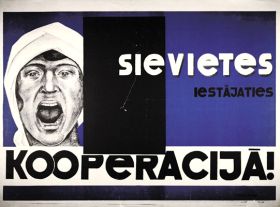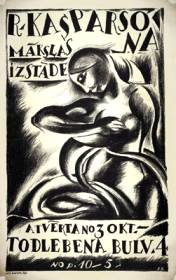
1. Sigismunds Vidbergs
Lithography, 112x71, 1936

2. Rihard Zarins
Lithography, 92x112, 1900

3. Raimonds Sisko
Lithography, 72x111, 1938

4. Niklavs Strunke
Lithography, 73x54, 1920
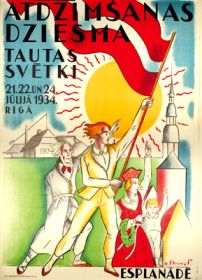
5. Niklavs Strunke
Lithography, 70x95, 1934

6. Vilis Krumins
Lithography, 52x70, 1921
The National Library of Latvia stores a unique collection of Latvian posters, still being replenished by new additions. The oldest of them dates back the year 1899. Predecessors of this type of advertising are preserved in the form of old playbills and leaflets commemorating different undertakings.
The collection includes works of acknowledged artists - Rihards Zarins, Bernhards Borherts, Sigismunds Vidbergs, Niklavs Strunke, Hermanis Grinbergs, and not so well known artists as well - Vilis Krumins, Oskars Steinbergs, Alfreds Svedrevics, Nikolajs Puzirevskis, Janis Ansons. Alongside them new creative presentations of young at that time authors are included, for example, Girts Vilks, Kurts Fridrihsons, Leonids Arins. The collection of artists working in Latvia is enriched by works of foreign colleagues, among them the poster by Raoul Dufy must be mentioned, which was displayed at the exhibition of French art in Riga. Some authors are unknown, some can only be guessed.
The posters confirm the presence of strong traditional realism, which is approbated in other forms of Latvian art, being even felt in modern creations.
Advertisements of the Art Nouveau epoch covering the period from the end of the 19th century up to the second decennial of the 20th century, inform about the active intellectual life taking place in Riga: activities of the Art Salon, Societies of the travelling artists or the exhibition of the so called Peredvizniki movement, inauguration of Riga Art Museum, Latvian Song Festival. World War I is reflected in posters likewise.
The years of the newly established independent Latvian Republic coincide with the period of classical modernism in art. A striking evidence of democratic changes is provided in the posters reflecting the Constitutional Convention, the succeeding elections of the Parliament, anxiety of the new state for the perished and lost children in the war. Latvian Army has been formed, but it is the air forces that attract the attention of artists most of all.
Various shows of artistic groups are advertised. New advertising agencies, press publications, different national organisations sprung to life. Different events take place, for example, exhibitions, advertising agricultural and industrial goods, carnivals, sport competitions, centenary of the press, masquerades, circus and cinema performances, song festivals.
The 30s are described as the period of Art Deco and new realism. The poster of this period reveals not only the economic development but also the negative consequences created by political changes. The authoritarian regime of Karlis Ulmanis depreciates the value of social and artistic life. “Latvian” is acknowledged to be the only virtue depicted in the endless variations of girls and boys in national costumes. Only the most talented artists manage to give life to these stereotypes. Positive image dominates. It is expressed by decorative elements of Art Deco and classicizing monumentalism of new realism. Co-operative movement develops, the leitmotif of the economic life is summed up in the challenge: "Latvian money for Latvian production". A number of enterprises advertise home products. Posters invite to enjoy healthy life style, to watch international sports competitions, to travel, to visit displays of foreign art and exhibitions of local artists.
The works from the beginning of the 40s, manifest the development of new realism to heroic one. This time brings crucial changes into the fate of Latvia. Soviet power roots out any value of secular life. Political posters, glorifying the new establishment, play a decisive role. World War II follows and dramatic fate of the Latvian nation continues. Without any choice Latvian soldiers are forced to fight in two hostile fronts. Their motto is personified in Kurts Fridrihsons’ poster "Hands off from Latvia".
Adapted from a text by Inta Pujate,
Master of Arts
© For reproducing images the permission of the NLL (National Library of Latvia) is required
Contacts:
Dmitrij Zinoviev, email dmitrijs@lnb.lv
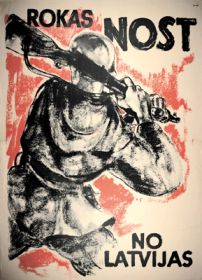
7. Kurts Fridrihsons
Lithography, 85x60, 1944
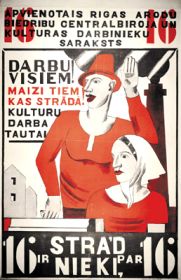
8. Niklavs Strunke?
Lithography, 92x60, without year
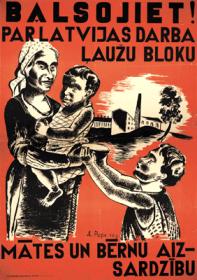
9. Augusts Pupa
Lithography, 96x68, 1940

11. Not signed
Lithography, 65x48, without year

12. Oskars Steinbergs
Lithography, 70x50, without year

13. Zenta Babolina
Lithography, 68x48, without year

